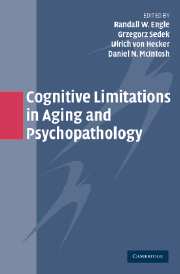Book contents
- Frontmatter
- Contents
- List of Contributors
- Preface
- Acknowledgments
- 1 Cognitive Limitations in Aging and Psychopathology: An Introduction and a Brief Tutorial to Research Methods
- SECTION I WORKING MEMORY AND COGNITIVE FUNCTIONS
- SECTION II AGING AND PSYCHOPATHOLOGY OF COGNITIVE CONTROL
- SECTION III ATTENTION, INHIBITION, AND REASONING PROCESSES
- 10 The Nature of Attentional Bias in Human Anxiety
- 11 Inhibition, Rumination, and Mood Regulation in Depression
- 12 Aging and Inhibitory Processes in Memory, Attentional, and Motor Tasks
- 13 Impairments of Memory and Reasoning in Patients with Neuropsychiatric Illness: Disruptions of Dynamic Cognitive Binding?
- 14 Generative Reasoning as Influenced by Depression, Aging, Stereotype Threat, and Prejudice
- Name Index
- Subject Index
- References
11 - Inhibition, Rumination, and Mood Regulation in Depression
Published online by Cambridge University Press: 20 May 2010
- Frontmatter
- Contents
- List of Contributors
- Preface
- Acknowledgments
- 1 Cognitive Limitations in Aging and Psychopathology: An Introduction and a Brief Tutorial to Research Methods
- SECTION I WORKING MEMORY AND COGNITIVE FUNCTIONS
- SECTION II AGING AND PSYCHOPATHOLOGY OF COGNITIVE CONTROL
- SECTION III ATTENTION, INHIBITION, AND REASONING PROCESSES
- 10 The Nature of Attentional Bias in Human Anxiety
- 11 Inhibition, Rumination, and Mood Regulation in Depression
- 12 Aging and Inhibitory Processes in Memory, Attentional, and Motor Tasks
- 13 Impairments of Memory and Reasoning in Patients with Neuropsychiatric Illness: Disruptions of Dynamic Cognitive Binding?
- 14 Generative Reasoning as Influenced by Depression, Aging, Stereotype Threat, and Prejudice
- Name Index
- Subject Index
- References
Summary
The mind seizes hold of something and simply cannot let it go.
– Winston ChurchillRumination, as described above by Winston Churchill, is a central, debilitating feature of depressive episodes and of other emotional disorders. Rumination means bringing an idea back to mind over and over again. Originally, the word referred to the way cows and certain other animals eat, storing partially digested food in a stomach called a rumen, bringing that food up later to chew over more thoroughly. Even in the original Latin, however, it took on a vivid figurative meaning, describing the practice of bringing an idea back to mind for further work-over. Many of us mull over important matters in this way, digesting them a little at a time. But in depression, rumination becomes less a deliberate practice of thinking but more an involuntary state of mind, featuring negative, self-deprecating statements and pessimistic ideas about the world and the future. To say to a depressed ruminator, “Just stop thinking about it” – whatever the “it” might be – is not very helpful.
Apart from being a debilitating symptom, rumination has also been linked to a heightened vulnerability for recurring depressive episodes and to prolonged depressive episodes. Therefore, a closer analysis of underlying causes and short-term and long-term consequences of this “symptom” of depression might facilitate our understanding of depressive disorders, ultimately leading to refined treatments and effective prevention.
However, a series of important questions on the relation of rumination and depression remains unanswered.
- Type
- Chapter
- Information
- Cognitive Limitations in Aging and Psychopathology , pp. 275 - 312Publisher: Cambridge University PressPrint publication year: 2005
References
- 51
- Cited by



